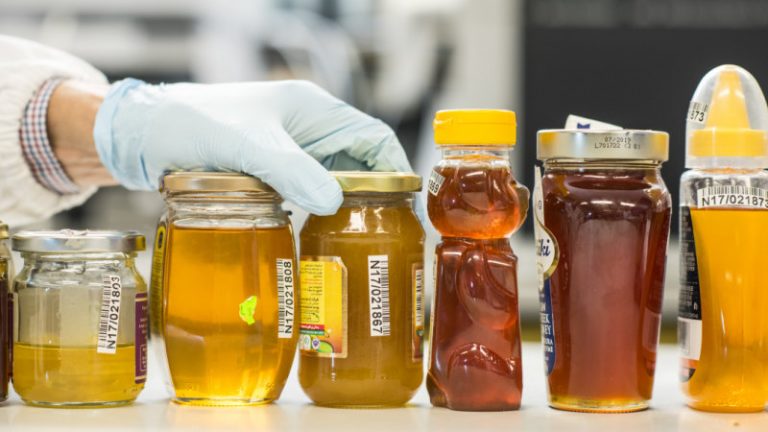People who make honey often put different kinds of syrups in it without anyone knowing. Up to now, it was challenging to discover the presence of sugars in honey.
However, a new method of testing has been discovered, and the same help in detecting syrups in honey. Almost half of the sold honey in Australia has low-priced sweetener in it; such as wheat syrup, rice syrup and sugar beet syrup.
28 honey samples have been taken from stores around the country and have been tested in laboratories in Germany to see if they have cheap sweeteners in them. It turned out that 12 of them are not honey, but some form of low-cost sugar syrup.
Reasonably, when you hear that these honey brands went past the official government purity tests, you will be worried.
Researchers say that honey producers are able to hide these sweeteners and to pass the tests.
Moreover, the official test, which is internationally accepted, is able only to detect honey mixed with corn and cane sugar.
Therefore, producers have come to a knowledge that tests cannot discover the difference sugar beet syrup, rice syrup and honey.
Nevertheless, the new technology called Nuclear Magnetic Resonance can.
Germany’s Quality Services International laboratory authorized the Australian horticulturalist Robert Costa to do both types of tests.
Not more than 14 samples passed the NMR tests, and of course, all 28 samples got through the official government C4 sugar test.
Emma Beckett, a molecular nutritionist from the University of Newcastle, says: “The C4 test picks up most fake honey, because most of the cheap sugar syrups used to make fake honey came from C4 plants, like corn and sugar cane. But, newer substitutes, like rice, wheat, and beet syrups, come from C3 plants, and so won’t be picked up.”
Gudrun Beckh is a QSI’s managing director. For almost 30 years, she has been testing honey. In her experience, NMR is the complete test for discovering if the honey has been watered down.
She explains: “Fake honey always existed, but in the last years it’s a growing problem because of the people who adulterate using more and more sophisticated methods, so it’s more complicated to detect it,”.
In 2018, by using the conventional C4 testing method, a study had found that in 27 per-cent of different Australian honey brands, manufacturers have put corn or cane syrup.
The ones with foreign honey, such as China, were adulterated.
Regarding the United States, they do not test the level of quality of honey; thus, the problem must be worse there.
A laboratory analysis, done in 2011, has shown that 76 per cent of the sold honey in the United States hasn’t pollen in it. This is an indicator that this honey must be from China and is watered down with low-cost sweeteners and has illegal antibiotics.
Professor and melissopalynologist Vaughn Bryant from Texas A&M University was authorized by Food Safety News to examine 60 brands of honey from stores in the United States.
He found out that all from the tested samples from fast food restaurants and drug stores, and 76 per-cents of the certified samples from stores had no pollen.
According to Mark Jensen, president of the American Honey Producers Association, there is no sense in removing pollen from the honey.
He adds: “Elimination of all pollen can only be achieved by ultra-filtering and this filtration process does nothing but cost money and diminishes the quality of the honey,”
“In my judgment, it is pretty safe to assume that any ultra-filtered honey on store shelves is Chinese honey and it’s even safer to assume that it entered the country uninspected and in violation of federal law.”
The beekeeper Richard Adee says: “It’s no secret to anyone in the business that the only reason all the pollen is filtered out is to hide where it initially came from and the fact is that in almost all cases, that is China,”.
The press officer Tamara Ward told Food Safety News that the FDA claimed that “the FDA does not consider ‘ultra-filtered’ honey to be honey,”.
If you buy honey which is categorized as organic you have more chances of real honey purchase. The laboratory results have shown that 71 per cent of the organic honey has pollen in them.
Maybe the best way to get real honey is to buy fresh, concentrated honey.
One ounce of fresh, thick honey has 16 minerals, 18 amino acids, 20 vitamins and a lot of phytonutrients and antioxidants. At the same time, this type of honey has antifungal, antiviral and antibacterial properties. It also has magnesium, calcium, potassium, sulphur, calcium sodium chlorine, phosphate and B2, B3, B5, B6, C.


Why not publish a list of which honey are adulterated and which are near pure. The public deserve this.
Absolutely. There’s not much sense in publishing this story if there is no listings of the pure and tampered honey.
I would give my right arm to know which brands are real and which are not real 100 percent honey because I use a lot of it. So how about some honest information on the subject.